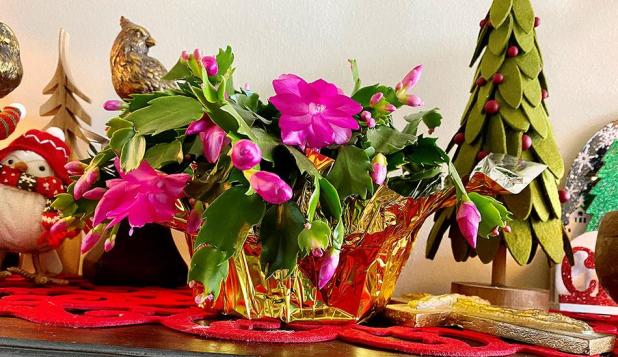
Holiday cacti come in a variety of colors. Blooms can be triggered by longer, cooler nights.
—LSU AgCenter/Heather Kirk-Ballard
Get It Growing: Deck the halls with tropicals
When it comes to decking the halls for the winter holiday season, we not only bring out the boughs of holly — whatever those are — we also often bring out the tropical plants, making it more appropriate to celebrate “Mele Kalikimaka.” I digress, but hopefully you get my point that the majority of plants we use to decorate during the winter holidays often come from tropical locations.
Take the poinsettia, for instance. It’s the No. 1-selling potted plant in the United States, making a significant annual contribution of $250 million to the nation’s economy. This impressive feat is achieved within a relatively brief market window of about six weeks.
Poinsettias are native to Mexico and Central America. In their native habitat, they grow as a woody shrub reaching 10 to 15 feet tall. Most people know these days that the colorful red flowers are actually modified leaves called bracts. The small clusters of yellow in the middle of the bracts are the flowers. Nonetheless, these are our holiday plant of choice.
It’s no wonder they are so loved. Poinsettias come in the most commonly used colors of the season of red, white and green. Today, there are more than 100 varieties in traditional and newer shades of pink, purple, orange and yellow. There are also marble and bicolor varieties. However, the favorite for consumers is still the traditional red.
Poinsettias aren’t the only plant we see this time of year. Next is the flowering holiday cactus.
Christmas cactus and holiday cactus are popular houseplants known for their attractive, colorful flowers that bloom during the holiday season. There is often confusion between the two, and the terms are sometimes used interchangeably. These too are native to tropical climates in Brazil, where they grow in the tree branches in rainforests.
They are a type of cactus, or succulent. But because of their growth habit, they are classified as epiphytes. An epiphyte is a plant that grows on another plant, usually a tree, without being parasitic. It relies on the host plant for support and obtains nutrients and moisture from the air, rain and surrounding organic matter. Epiphytes attach to the host plant by clinging to its bark or branches, much like Spanish moss. This is in stark contrast to a true parasite — another one of our famous holiday decorations.
That brings us to mistletoe. This is a hemiparasitic plant that grows on trees and shrubs. The tradition of kissing under the mistletoe dates back to Norse mythology, where it was associated with the goddess of love, Frigg. This custom gained popularity in Victorian England and has since become a festive tradition during the winter holidays, symbolizing love, peace and goodwill.
Mistletoe is commonly used as a decorative element hung in doorways. The tradition of kissing under it continues in many cultures. Be careful, however, as some mistletoe species can be toxic if ingested, especially for children and pets. It’s best to use artificial mistletoe for safety.
So, move over mistletoe — and let’s get back to sorting out those different kinds of holiday cacti. You can easily remember the different species in two ways: the time when they bloom and the leaf shapes.
Christmas cactus (Schlumbergera x buckleyi) typically blooms around Christmastime, hence its name. It has flattened stem segments with scalloped edges and flowers that can be white, pink, red or purple. The blooms have a drooping habit and tubular shape.
Thanksgiving cactus (Schlumbergera truncata) tends to bloom a bit earlier, usually around Thanksgiving in the Northern Hemisphere. It has flattened stem segments with more pointed, claw-like projections. The flowers are similar to the Christmas cactus with its tubular shape in various colors, including shades of pink, red and white.
Lastly, there is the Easter cactus (Hatiora gaertneri) that blooms in the springtime. While not as common as the Christmas and Thanks-giving cacti, the Easter cactus has flattened stem segments, and the flowers are more star-shaped compared to the tubular blooms of the other holiday cacti.
Holiday cacti prefer bright, indirect light. They can tolerate some direct sunlight, especially during the morning hours, but too much direct sun can lead to leaf burn.
Additionally, they thrive in a cool to moderate environment. Avoid exposing them to extreme temperatures, especially drafts and cold air, and make sure soil is well drained. Treat cacti as you would an orchid.
Allow the top inch of soil to dry before watering. Overwatering can lead to root rot. They appreciate higher humidity levels, but they can adapt to average indoor humidity.
Holiday cacti can be easily propagated from stem cuttings. Simply take a segment of the stem, let it callus for a day or two, then plant it in a well-draining potting mix.
Holiday cacti require a period of cooler temperatures and longer nights to initiate blooming. To encourage blooming, expose the plant to cooler temperatures (around 50 to 55 degrees F) and limit its exposure to light for about 12 to 14 hours per day for several weeks.
This happens naturally each year in the fall, so plants should automatically go into bloom if they are protected from artificial light at nighttime.
